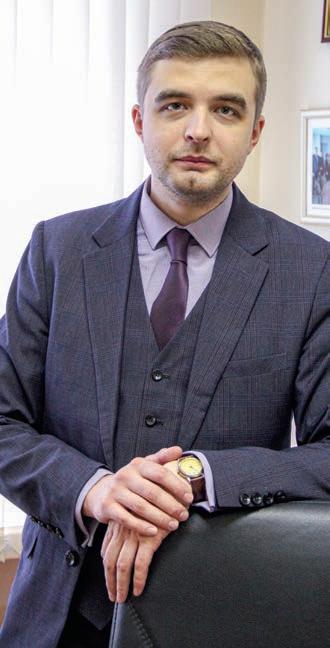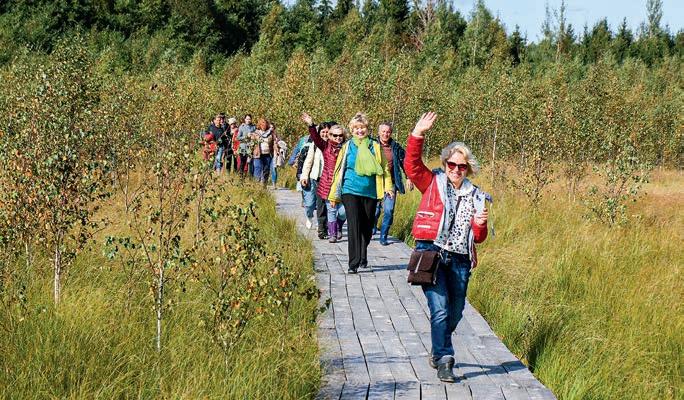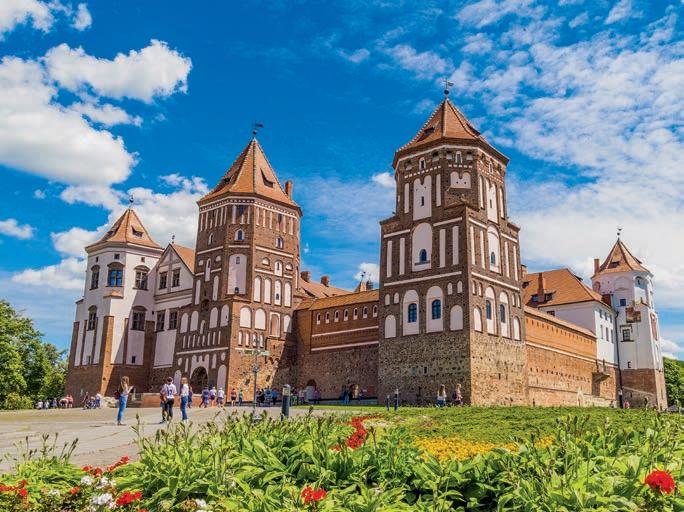
13 minute read
New opportunities new impressions
The fact that the tourism industry worldwide is going through hard times – is not news. The main problem of this, which, of course, has not bypassed Belarus, is also well known. The pandemic. it was it that made those negative adjustments that directly affect the service sector. Therefore, the most urgent question was to what extent tourist organizations, including the Belarusian ones, were able to reorganize, in a timely manner to reformat their work. how professionally do they know how to respond to the challenges of the time, what is in the arsenal of travel offers for tourists' requests, in what way, in what direction are new travel trends being formed today? We talked about all this with pavel sapotko, a senior lecturer at the department of intercultural communications of the Belarusian state university of culture and Arts.
– In your opinion, has the Belarusian tourism industry been able to reorganize itself, responding to the well-known challenges of recent times?
Advertisement
– In connection with the coronavirus epidemic, the center of gravity in the country has shifted to domestic tourism, which is a powerful resource in terms of both socioeconomic development, and the revival of regions, and civic-patriotic education. Today Belarus is actively developing cultural, educational, military-historical, rural, industrial, medical and gastronomic tourism. Last year, new tourist programs were developed, excursion routes were updated, interesting ideas of clusters, uniting objects and attractions of several regions of the country at once, appeared. The list of services in Belarusian agricultural estates has been significantly expanded, new proposals related to historical reconstruction have announced themselves. Museums, which are actively introducing various mobile applications, virtual and augmented reality, and audio guides, do not stand aside. All this fills tourism with new content, encourages Belarusians and guests to travel, watch, get acquainted with the country.
– How do you think the tourism sector of Belarus will develop in the near future?
– Today the priority is the creation of new competitive tourism programs. For this, the resource of tangible and intangible historical and cultural heritage, natural heritage, social and cultural institutions – museums, galleries, Theatres, craft houses, folklore centers, parks of culture and recreation, zoos is used. I believe that farmsteads, catering organizations and sanatoriums can make themselves known even more actively. There is a huge reserve of newsworthy events – festivals, holidays, exhibitions and fairs, programs of historical reconstruction.
One of the most important tasks is the wide information support of the tourism sector: holding of press tours, organization of special projects with the media, preparation of special issues of printed publications, launching of thematic headings in social networks, preparation of a cycle of programs on television. It seems relevant to create
Pavel Sapotko
videos about the tourism opportunities of Belarus, each region and the city of Minsk with further ensuring of their wide broadcast on Belarusian television, own information resources, portals of partner organizations, websites of Belarusian diaspora organizations in different countries of the world. It is important to develop digital platforms, electronic means of tourist navigation, mobile applications in the promotion of a tourist product.
Both abroad and in our country, it is promising to create full-fledged projects in the form of "golden rings", tourist clusters, and destinations. This is when a person, having arrived in some region, no longer, in fact, has to no longer to care about anything. His/her full-fledged rest is formed by a network of tourist components, including historical sites, health centers, catering facilities, cultural institutions, etc. A tourist can spend time actively and with interest, diversifying his/her leisure as much as possible. The winners now will be those regions and tourism entities that were able to unite in time and offer some interesting product on a competitive basis. Good examples of this kind are now in the field of agroecotourism, when estates unite and receive tourists on the territory of a region, offering them a unique, rich program. For example, in one agriturismo, batleyka performance is demonstrated, in the other they teach how to play ancient musical instruments, in the third they hold a master class on clay products creation, in the fourth they float on kayaks, in the fifth they invite to the contact zoo, in the sixth they conduct tasting of dishes of national Belarusian cuisine. It turns out that a tourist gets to know the region through the prism of activities, cultural heritage and historical past, and also communicates with people. As a result, such a vacation will undoubtedly be remembered by travelers, and not one, but several agro-estates will benefit.
At one time, within the USAID project "Local Entrepreneurship and Economic Development", implemented by the United Nations Development Program, local communities received an incentive to create about 20 tourist destinations in different regions of Belarus in the form of agroecotourism clusters: in Brest region – "Belovezhsky tract", "Valley of the Yaselda River", "Baranovichi Green Ring", "Motol Shlyakh"," Mukhovets Kumora", "Pinsk Polesie", "Amazonia of Polesie", in Grodno region – "Green Amulet of Hrodna", "Zelvenski Dyyarush", "Mickiewicz Land", "The Land of Pushcha's wonders and mysteries", "Mir County", "The Legacy of Gediminas", "In the Footsteps of Ancient Miners", "Northern Athens", "Northern Vector of Grodno Region", "Schuchin Destination".
Statistics show that about 15 tourist routes are developed annually on average in Belarus. Last year, for example, appeared such routes as "Trostenets", "Architectural and Historical Monuments of Slonim, Zhirovichi and Synkovichi", "Between Baranovichi and Gantsevichi: at the Crossroads of History", "Orsha district – a journey into the past and present of the land", "Lost Paradise: Life and Catastrophe of Belarusian Shtetls". A number of excursions are conducted in foreign languages – in English, German, Chinese. These are such excursions as "Brest – ancient and modern city", "Mound of Glory", "Khatyn Memorial Complex", "Architectural and Historical Monuments of Kossova and Ruzhany", "The Road to Dudutki".
Despite the difficult epidemiological situation, one should not discount the possibilities of international and crossborder cultural tourism. Since 1987, the Council of Europe has been implementing a large-scale project "European Cultural Routes", which sets as the main tasks the encouragement of travel of citizens of different countries and the study of their historical past, the determination of the identity of local cultures in the context of the world cultural heritage. There are more than 40 cultural routes, each of which allows a broad interpretation of the diversity of the cultural potential of Europe. Belarus participates in two routes: "The European path of Jewish heritage", which assumes the acquaintance of tourists with the rich material and spiritual heritage of the Jews (together with Azerbaijan, Belgium, Bosnia and Herzegovina, Croatia, Czech Republic, France, Georgia, Germany, Italy, Lithuania, Poland, Romania, Serbia, Spain, Portugal, Turkey, Great Britain) and "VIA REGIA", which is the oldest and longest road connecting Eastern and Western Europe, which previously served for the resettlement of migratory tribes in the Stone Age and promoted the development of trade in the Middle Ages, and now known as PanEuropean Transport Corridor III (jointly with France, Germany, Poland, Belarus, Ukraine).
I consider it important to develop cooperation between twin cities – regions between which friendly ties have been established in order to develop cooperation in the humanitarian sphere. Diplomacy of cities is an effective means of intercultural

Yelnya. Participants of the festival "Cranes and Cranberries"
dialogue and translation of the values of international friendship, harmony, unity and partnership, a tool for popularization of the historical and cultural heritage of twin cities and increase of the tourist flows, the possibility to implement humanitarian programs.
– Taking into account the international aspect of tourism, it is impossible not to ask why, first of all, Belarus is attractive for foreign guests? What are the country's competitive advantages here, if I may say so?
– Our powerful potential is expressed in majestic castles and palaces, ancient temples of different denominations, picturesque natural landscapes, unique national parks and reserves, vibrant festivals and holidays, rich intangible heritage, magnificent national cuisine and much more. I would like to remind you that in 2016 – 2018 the Republic of Belarus occupied a leading position in the Agritourism nomination of the National Geographic Traveler Awards rating. In 2017, the authoritative British newspaper The Times included Minsk in the top 30 cities attractive for weekend vacations. In 2019, the British newspaper The Independent presented the Belarusian capital in the list of European cities that are recommended to visit. Belarus was included in the top ten countries for travel in the same 2019, according to the international publishing house "Lonely Planet".
Our national parks are world famous: "Belovezhskaya Pushcha", "Narochansky", "Pripyatsky", "Braslav Lakes", as well as Berezinsky Biosphere Reserve and Polesie Radiation-Ecological Reserve.
Belarus is worthily represented in the UNESCO World Heritage List by such iconic places as the National Park "Belovezhskaya Pushcha", the Castle complex "Mir", the architectural and cultural complex of the Radziwills' residence in the town of Nesvizh, points of the transboundary object "Struve Geodetic Arc". The List of Intangible Cultural Heritage includes the Christmas rite "The Kalyady Tsars (Christmas Tsars)" in the village of Semezhevo, Kopyl district, Minsk region, spring rite "Yury round dance" in the village of Pogost, Zhitkovichi district, Gomel region. The Representative List of the Intangible Cultural Heritage of Humanity includes the Catholic festival "Celebration in Honor of the Budslau Icon of Our Lady (Budslau fest)" in Volozhin district of Minsk region, the traditions of the tree beekeeping in Belarus and Poland.
There are amazing heritage sites in our country: the Transfiguration Church of the 12th century in Polotsk, Gomel palace and park ensemble of the 18th – 19th centuries, Borisoglebsk (Kolozha) church of the 12th century in Grodno, Kamenets tower of the 13th century in Brest region, Augustow Canal of the 19th century in Grodno region, defensive churches of the 16th centuries in the village of Synkovichi of Zelva district and in the village of Murovanka of Schuchin district, the complex of the former Jesuit monastery of the 16th-19th centuries in Nesvizh, Brest fortress fortifications complex of the 19th-20th centuries and many others. Restoration work has been completed at such iconic objects as Kossovo palace and park ensemble, the Holy Dormition Cathedral in the urban village of Zhirovichi of Slonim district, Sapega palace complex in Ruzhany, Pruzhany district, and the palace and park ensemble in the village of Zhilichi, Kirovsk district. Restoration work continues on the Old Castle in Grodno, Holshany Castle in Oshmyany district and Krevo castle in Smorgon region, in the palace and park complex in the village of Svyatsk, Grodno region.
– As you know, museums are an important link in the tourism system…
– Today, Belarusian museums have interesting permanent exhibitions, organize temporary exhibition projects, carry out programs of historical reconstruction, create interactive complexes, and offer a variety of souvenirs. A trip to the museum is an immersion in history and acquaintance with the rich culture of Belarusians. Relatively new museums were able to show themselves with interesting expositions. Such as the Museum of Byalynitsky-Birulya in Mogilev Region – a branch of the National Art Museum of the Republic of Belarus, the Museum of History of Vitebsk People's Art School – a branch of Vitebsk Center for Contemporary Arts, the Museum of Stanislav Monyushko – a branch of Cherven District Museum of Local Lore in the urban village of Smilovichi. Tourists will undoubtedly be interested in getting acquainted with the new permanent expositions – such as "Museum of War – Territory of Peace" in the Memorial Complex "Brest Fortress-Hero", "Minsk. Upper town. Archaeological Museum" in the Museum of History of the City of Minsk, "Belarusian Jews" in Ivye Museum of National Cultures. Departmental and school museums are also of considerable interest.
The festival map of Belarus is diverse. These are the International Festival of Arts "Slavianski Bazaar in Vitebsk", the Republican holiday "Kupalye" ("Alexandria Gathers Friends") in the agro-town Alexandria of Shklov district of Mogilev region, the International Festival "Belarusian Musical Autumn" in Minsk, the International Youth
Yury round dance

Theatre Forum "M.art.contact" in Mogilev, the International Festival of Theatre Arts "Slavic Theatre Meetings" in Gomel, the International Festival of Ethnocultural Traditions "The Call of Polesie" in the agro-town Lyaskovichi of Petrikov district of Gomel region, the National Festival of Belarusian Song and Poetry in Molodechno.
And what impressions will a foreigner have after visiting the ballets "The Nutcracker" or "Swan Lake" staged by Valentin Elizariev at the Bolshoi Theatre of Belarus? Or a visit to BelAZ and acquaintance with the world's largest 450-ton dump truck recorded in the Guinness Book of Records? Or travel through the fabulous Belovezhskaya Pushcha and Pripyat Polesie? He/she will never forget Belarus and will certainly want to come back here again!
Agroecotourism is a unique phenomenon that Belarus has become widely known for lately. Today, Belarusian agro-estates offer interesting excursions to the regions, animation programs, bicycle and water trips, master classes on the reconstruction of national rituals, interactive horse shows, musical evenings, batleyka performances, and tastings of national cuisine.
It should be said that, thanks to qualified specialists and modern medical centers, people go to Belarus for treatment, as well as to receive medical advice. A large number of foreigners visit our country in order to improve their health in Belarusian health resorts. Popular are the sanatoriums "Yunost" (Minsk district), "Sosny" (Myadel district), "Belorusochka" (Minsk district), "Forest Lakes" (Ushachi district), "Sosnovy Bor" (Molodechno district), "Belaya Vezha" (Kamenets district) and others.
Meanwhile, very interesting programs for tourists are offered by Belarusian industrial enterprises, including BelAZ, MTZ, and Kommunarka confectionery factory. Tourists are already fond of visits to Neman glass factory, Slutsk Belts and Belkhudozhkeramika factories, Babushkina Krynka and Savushkin Product dairy factories, where excursions are accompanied by lectures, meetings with experts, product inspection, tastings, and master classes. In the near future, the agency will hold introductory events for guides and guides-interpreters at the enterprises of Bellegprom concern. We have recently held negotiations with the management of the National Film Studio "Belarusfilm", which has a unique fund of game props. I am sure that the process of making films both in the pavilions and at the raunch will be interesting for tourists.
– What, in your opinion, is the role of tourism in civic and patriotic education?
– Tourism is an effective means of patriotic and moral upbringing, primarily of the younger generation. Recently, a seminar was held at All Saints Church on the topic of patriotic education by means of educational tourism. I was surprised and delighted with how interesting, information-rich events are held by the Republican Center for Ecology and Local History, school museums. Why not to include the latter in full-fledged tourist routes? Not all of them, maybe, are rich visually, but many school museums have unique items and, sometimes, there are rare exhibits that republican museums would also dream of. I recall the words of the State Secretary of the Union State Dmitry Mezentsev, who very accurately noted in one of his speeches: "As soon as we stop coming to the monuments, then for ourselves and our youth we will close the moral scale for assessing what has been done for us." Brest Fortress, the Belarusian State Museum of the History of the Great Patriotic War, Khatyn, the memorial complexes "Trostenets", "Ola", "Krasny Bereg" should be shown to both our and foreign tourists. Such objects, more than any other means, help to effectively fight the falsification of our history, not always adequate interpretations of its individual facts, opposing all this with documentary truth, even if it is sometimes too harsh. Today, this topic is in demand by societies and is very relevant. This is evidenced by the Law "On Prevention of Rehabilitation of Nazism", recently signed by the President. In general, the theme of the war, the memory of it is immortalized in Belarus very emotionally. How could it be otherwise in a country that lost every third inhabitant in those terrible years?! Fedor Povny, the hegumen of All Saints Church, once shared his observation: an excursion group of teenagers from an educational institution for children from disadvantaged families walked through the exposition of the Museum of Memory, entered the crypt of the Memorial Church, listened to the guide's story... After that, there was a feeling that the children had matured for a year.
Interviewed by Vladimir Mikhailov

Mir Castle




